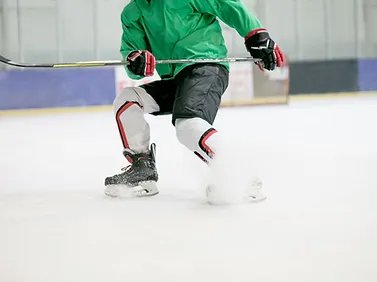Hip Labral
Tears and Disorders
Injury Guide

Hip labral tears are a common injury among athletes that can significantly impact their performance and quality of life, particularly those involved in sports that require repetitive hip movements, such as soccer, hockey, ballet, and martial arts. These tears occur in the ring of cartilage, known as the labrum, that surrounds the hip joint. Athletes who experience hip labral tears often require specialized rehabilitation to recover and regain optimal function. In this essay, we will discuss the symptoms, causes, and rehabilitation strategies for hip labral tears, with a focus on assisting athletes in making an informed decision about seeking treatment.
Symptoms:
Hip labral tears can present with various symptoms, which may vary from athlete to athlete. While this injury can affect anyone, certain athletes may be more prone to hip labral tears due to the nature of their sport and the repetitive motions involved.
Hip pain is a primary symptom experienced by athletes with hip labral tears. This pain is typically felt in the groin area or deep within the hip joint. It can be sharp, dull, or a combination of both, and tends to worsen during physical activities such as running, jumping, or twisting motions.
Limited range of motion is another symptom that athletes may experience. Movements such as squatting or pivoting can become challenging and uncomfortable due to the decreased flexibility in the hip joint. Athletes involved in sports that require extensive hip mobility, such as dancers or gymnasts, may be particularly impacted by this symptom.
Athletes with hip labral tears may also notice a clicking or catching sensation within the hip joint. This sensation is often felt during certain movements, such as rotating the hip or when walking. Athletes engaged in activities involving repetitive hip rotation, such as golfers or baseball pitchers, may be more susceptible to experiencing this symptom.
Hip instability, characterized by a feeling of the joint giving way or lacking support, is another symptom commonly associated with hip labral tears. Athletes may experience difficulties with balance, coordination, and overall athletic performance. Sports that involve quick changes in direction, such as basketball or soccer, may put athletes at a higher risk of experiencing this symptom.
Anatomy:
To visualize the hip joint labrum on the model above, use the 🔍 button to search for acetabular labrum. Now remove the hip joint ligaments and joint capsule. The thin later of connective tissue surrounding the ball of the joint is the acetabular labrum.
The hip joint is a ball-and-socket joint consisting of the femur (thighbone) and the acetabulum (socket) of the pelvis. Surrounding the rim of the acetabulum is the labrum, a ring of cartilage that provides stability and cushioning to the hip joint.
When a labral tear occurs, it disrupts the function of the hip joint, which has several implications.
One significant implication is joint stability. The labrum plays a vital role in stabilizing the hip joint. A tear in the labrum can reduce joint stability, leading to a feeling of instability for athletes. This can affect their balance, coordination, and overall athletic performance.
Another implication is the increased friction within the joint. The labrum provides a smooth surface for the femoral head to move within the acetabulum. However, when a tear occurs, this smooth interaction is disrupted, causing increased friction. As a result, athletes may experience pain and discomfort during movements involving the hip joint.
Labral tears can also lead to altered biomechanics. Athletes often compensate for the pain caused by a labral tear by modifying their movement patterns. These compensatory movements can lead to imbalances in muscle strength and coordination, potentially increasing the risk of further injuries or impairing athletic performance.
Moreover, labral tears can carry the risk of degenerative changes within the hip joint. If left untreated, the altered mechanics and increased friction can accelerate wear and tear on the articular cartilage, potentially leading to long-term complications such as osteoarthritis.
Causes:
Hip labral tears can occur due to a variety of factors, often related to repetitive motions, trauma, or structural abnormalities.
Repetitive motions, such as running, jumping, or pivoting, can lead to hip labral tears over time. The constant repetition of these movements causes wear and tear on the labrum, resulting in tears.
Hip impingement, where there is abnormal contact between the hip socket and the femoral head, increases the risk of hip labral tears. This condition places excessive pressure on the labrum, leading to tears.
Direct trauma to the hip joint, such as a fall or a forceful impact, can cause immediate labral tears. Athletes involved in contact sports or those who experience sudden injuries are at higher risk.
Rehab Strategies:
Pain management is a priority, because pain impairs coordination of hip stability. Various modalities including cryotherapy, electrical stimulation, and manual therapy can be helpful to relieve pain and inflammation. By managing pain effectively, athletes can begin to learn effective movement as early as possible.
Restoring the hip’s range of motion is a primary objective of rehabilitation. Our therapists prescribe specific exercises and stretches to improve flexibility and ensure athletes can perform essential movements without discomfort.
Strengthening exercises are essential for hip stability and injury prevention. Our therapists design personalized programs targeting the muscles surrounding the hip joint, including the glutes, quadriceps, and hip abductors. These programs gradually progress in intensity and difficulty as the athlete’s condition improves. Strengthening of the deep rotators of the hip are of greatest importance due to the role they play in centering the femoral head in the acetabulum. Use code 7JZZVGTC at medbridgego.com to learn our favorite exercise for the deep rotators of the hip.
Functional training is incorporated to prepare athletes for a safe return to their specific sport. By mimicking the movements and demands of their sport, functional exercises gradually reintegrate athletes into activities such as running, cutting, and jumping.
Hip labral tears can be debilitating for athletes, impacting their performance and overall well-being. At Latitude Physiotherapy, we provide tailored rehabilitation strategies focusing on pain management, range of motion exercises, strengthening, functional training, and education to help athletes regain optimal function and prevent future injuries.
Let’s
Work
Together
Ready to get started? Click here. General questions? Read our FAQ page. Have a specific question? Leave us a message!
